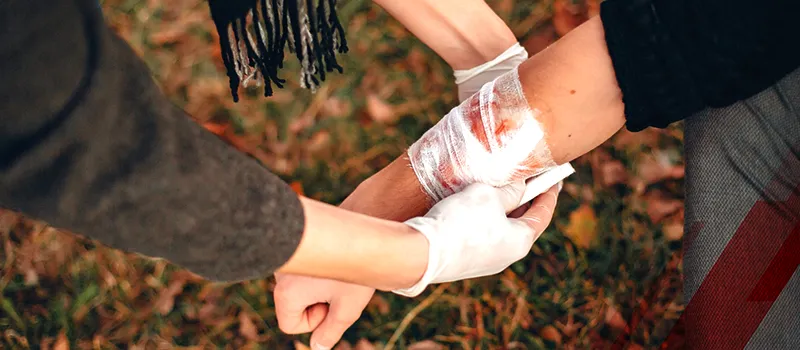Everybody has endured a painful paper cut or ingrown toenail. You don't need to pay much attention to the majority of minor wounds because they heal so quickly on their own. But what about when a wound doesn't heal completely? The very thought is unsettling, isn’t it?
Your burn or blister doesn't regenerate into new, healthy skin instead, it turns red and infected over time, getting worse. These wounds that just won’t heal are regarded as chronic wounds after 30 days and need specialized care to recover entirely. Let’s dive in and understand the world of chronic wound care.
What Exactly is a Chronic Wound Care?
Chronic wound care refers to the ongoing treatment and management of non-healing or slow-healing wounds. When a wound lasts for more than a month with little healing, it is formally classified as a chronic wound that needs special medical care. The most typical types of chronic wounds include diabetic foot ulcers, venous leg ulcers, and pressure ulcers. Chronic wounds can be caused by underlying medical problems like diabetes or by environmental triggers like pressure or friction. Chronic wounds can be difficult to treat and manage, often requiring a multimodal strategy that includes improved underlying health problems, effective wound care, and infection control.
According to Kings Research, the global Chronic Wound Care Market is projected to reach USD 15.51 billion by 2030, growing at a CAGR of 4.28% from 2023 to 2030. This number indicates the positive trajectory market growth set for the future.
Typical Forms of Chronic Wounds
Chronic wounds come in a variety of shapes, sizes, and locations, but the following categories are the most prevalent.
- Diabetic Ulcers
Extreme ulcers on the lower part of the body, particularly the feet, are a typical complication in people with diabetes because the disease interferes with the body's normal healing process. Common cuts, blisters, and scrapes are the initial symptoms of diabetic foot ulcers, but with time, they progress to become deep wounds with serious infections.
It's crucial to visually check your feet each day because nerve degeneration may make it difficult for you to feel the agony of a diabetic foot ulcer.
- Post-Surgical Wounds
Surgery can save your life, but unfortunately, surgical incisions are prone to infection and bacterial growth. A chronic wound may form if a surgical wound you have doesn't heal normally.
Keep an eye out for any indications of fluid retention, throbbing, streaks, or redness near the surgery site. A strong odor and a low fever are other signs that your post-surgical wounds need attention.
- Traumatic Lesions
Any form of extreme trauma or injury to the body, such as an intense burn, has the potential to cause harm that the body's inherent healing mechanisms might not be to repair. This happens as a result of significant trauma, which impairs the normal, healthy reparative response of cells and tissues by causing prolonged, excessive, and chronic inflammation, ongoing infections, and even drug-resistant bacteria.
- Arterial Ulcers
Chronic sores, known as arterial ulcers, are easily identified by their rounded appearance. They result from inadequate blood flow in the legs and feet. An arterial ulcer may be present if you suffer pain in your legs after exercise or when your legs are lifted.
What’s the Difference Between a Chronic and Acute Wound?
Even though both chronic and acute wounds are bodily traumas, their recovery times differ. Acute wounds can progress through the stages of healing and resolve themselves in a timely way, but chronic wounds fail to heal during a typical or anticipated period of recovery.
In general, a wound is considered chronic if it persists for more than 30 days without healing, while an acute wound gets cured or improves in a shorter time.
What are the Different Stages of Open Wound Healing?
Hemostasis, inflammation, proliferation, and maturation are the four physiological stages of wound healing that take place from the time a wound first appears to the time it heals. A wound gets "stuck" in the inflammatory phase and becomes a chronic wound if these four steps don't happen appropriately.
Hemostasis: Hemostasis starts to happen right away after an injury. Blood clots shield the underlying tissues from infection while preventing excessive blood loss and forming a scab. Platelets, fibroblasts, and proteins interact throughout this intricate and crucial process.
Inflammation: The inflammation phase begins after hemostasis. Common indications of inflammation, such as redness, warmth, swelling, discomfort, and loss of function, are brought on by an influx of inflammatory cells into the area.
Since early inflammation is intended to control bleeding and ward off infection in the wound, it is a positive indicator. Less than seven days of inflammation suggests that platelets, white blood cells, and other cells are actively promoting recovery.
Multiplication Phase: The wound regenerates with new tissue formed of young, healthy collagen during the proliferative phase, which can last two to three weeks in a wound that is effectively healing. To adequately supply this new tissue with nutrition and oxygen, new blood vessel networks are built.
The proliferative stage also aids in the reduction and concealment of the wound. Red and pink tissue indicate successful, healthy wound healing.
Maturing Phase: The maturity stage supervises the successful resolution of appropriate wound healing. To assist in the complete closure of the wound with new tissue, newly formed type III collagen changes into type I collagen. Collagen fibers rearrange themselves into more effective cross-links, and any excess cells that were utilized to aid in wound repair are eliminated.
Cross-linking minimizes scarring and promotes the strength of the skin over an existing wound. Though it might last up to a year, it is ideal for this remodeling to begin three weeks after a wound is inflicted.
Diagnosis Methods Explained
Identification of the root cause of the chronic wound is crucial to gaining control over the underlying factors contributing to its persistence. For instance, if diabetes is the cause of a leg or foot ulcer, your doctor may examine your blood sugar management and suggest that you visit a podiatrist to treat the ulcer and prevent it from coming back in the future. Surgical vein therapy may be necessary if a varicose vein-related ulcer develops.
Diagnosis methods for a chronic wound may include:
- Physical examination, which examines the wound and evaluates the local blood and nerve supply
- Medical history, including details about ongoing illnesses, recent operations, and medications you take now or have recently taken
- Blood and urine tests
- Biopsies of the injury
- Looking for any (pathogenic) disease-causing microbes through a wound culture
Winding Up
Managing chronic wounds efficiently can be a complex medical issue that requires a multidisciplinary approach. These wounds can be challenging to treat and maintain despite developments in medical technology and treatment options. This frequently lowers patients' quality of life and imposes a financial strain on healthcare systems.
Healthcare professionals, patients, and caregivers must work together to successfully treat chronic wounds, focusing special attention on wound assessment, debridement, and effective wound care management. The future of chronic wound care holds great promise because of ongoing research and development and the possibility of innovative therapies and interventions to improve patient outcomes and overall quality of life.




